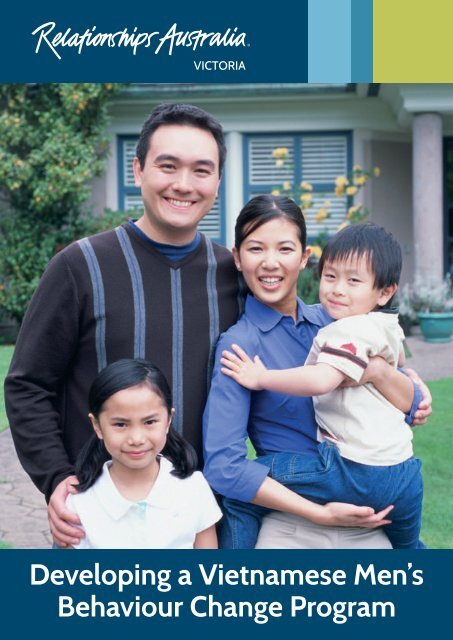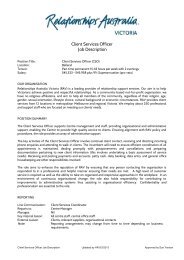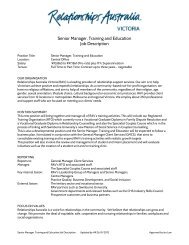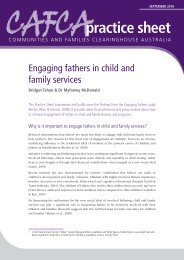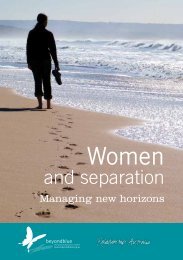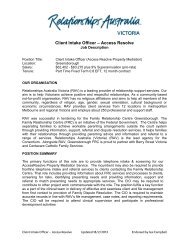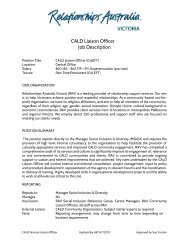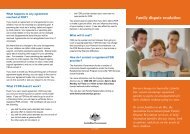Developing a Vietnamese Men's Behaviour Change Program
Developing a Vietnamese Men's Behaviour Change Program
Developing a Vietnamese Men's Behaviour Change Program
Create successful ePaper yourself
Turn your PDF publications into a flip-book with our unique Google optimized e-Paper software.
ContentsAcknowledgements................................................................................... 2Introduction............................................................................................... 3Background............................................................................................... 4About the <strong>Program</strong>:................................................................................... 6Collaboration......................................................................................... 6Ongoing Community Education............................................................ 7Session Improvements.......................................................................... 7Development of the group to NTV standards......................................... 8Project Outcomes: a discussion................................................................ 9Outcome 1 & 2..................................................................................... 9Outcome 2.......................................................................................... 11Outcome 3.......................................................................................... 13Limitations to the evaluation method through surveys.............................. 14Conclusion and recommendations........................................................... 15Appendix 1: Results................................................................................. 17Appendix 2: Reference list....................................................................... 241
Acknowledgements<strong>Developing</strong> a <strong>Vietnamese</strong> Men’s <strong>Behaviour</strong> <strong>Change</strong> <strong>Program</strong> report writers:Editors:Robyn McIvorKatrina MarkwickBronwyn ThwaitesKate GreenRelationships Australia Victoria has worked in partnership with the following organisationsforming a reference group that has provided input, support and direction to the groupfacilitators and to the project:inTouch Multicultural Centre against Family ViolenceDjerriwarrh Health ServicesKildonan Uniting CareThe Victorian Foundation for Survivors of TortureNo To Violence Male Family Violence Prevention AssociationAustralian <strong>Vietnamese</strong> Women’s AssociationDepartment of Human ServicesNeighbourhood Justice CentreDepartment of JusticeVictoria PoliceDoutta Galla Community HealthBrotherhood of St Laurence (Ecumenical Migration Centre)The family violence team of RAV’s Sunshine Centre is particularly acknowledged for theirmentoring, support, wisdom and sharing of resources with the <strong>Vietnamese</strong> facilitators of the<strong>Vietnamese</strong> Men’s and Family Violence group and for sharing their manager.Special thanks to RAV’s Kew Centre and Ballarat Child and Family Services for willinglyembracing the <strong>Vietnamese</strong> facilitators and allowing them to undertake practicum training tocomplete their qualifications.2
IntroductionRelationships Australia Victoria (RAV) has been providing relationship support services toVictorians for more than 60 years.Our centres have a range of family and relationship services for men including counselling,men’s groups, family dispute resolution, assistance on relationship and parenting mattersand education courses on relationship issues and personal growth.The Sunshine Centre runs entry level, behaviour change and ongoing ‘mentor’ groups formen who have been violent and controlling towards family members.In 2010, the Centre gained a Legal Services Board grant to establish a Men’s <strong>Behaviour</strong><strong>Change</strong> <strong>Program</strong> for members of the <strong>Vietnamese</strong> community in Melbourne’s Northwesternregion. This group was to be facilitated by <strong>Vietnamese</strong> speaking facilitators of both gendersand to run for fifteen weeks with an initial focus on torture, trauma and cultural issues, withfurther content including themes covered in mainstream groups regarding responsibility ofthe men and safety of the women and children.The Sunshine RAV Centre managed the program in partnership with a reference groupincluding Kildonan Uniting Care, Djerriwarrh Health Services, inTouch Multicultural CentreAgainst Family Violence, (inTouch), Australian <strong>Vietnamese</strong> Women’s Association, (AVWA),TheVictorian Foundation for Survivors of Torture, (VFST), No To Violence Male Family ViolencePrevention Association, (NTV).The program’s proposed outcomes were:1. decreased prevalence of violence within the families of the menparticipating in the group as evidenced by the men’s partners through women’sstories that the violence has decreased.2. increased access to support and relevant services for <strong>Vietnamese</strong>speaking women and children who have experienced family violence and for the<strong>Vietnamese</strong> men who have used the family violence.3. increased learning in relation to family violence with the targetedCulturally and Linguistically Diverse (CALD) community by the referencegroup, which may assist the partners in including new practices intowork that would further enhance our work with men and our work aroundthe safety of women and children.The program was accountable to a reference group comprising representatives from partnerorganisations.3
BackgroundThe population of Melbourne’s Northwest region is culturally highly diverse. For example,Australian Bureau of Statistics data 2006 for Brimbank and Maribyrnong show that morethan 50% of the population speaks a language other than English, with <strong>Vietnamese</strong> the nextmost common language.CALD women are identified in the Victorian Government’s Common Risk AssessmentFramework (Domestic Violence Resource Centre Victoria, 2008) as one of the groups atgreatest risk of family violence. Research has indicated that cultural difference, gender roles,familism, shame and collectivism often combine with factors related to the experience ofmigration to place immigrant and refugee women at heightened risk from domestic violence.(Pease & Rees 2008).There had been some previous work undertaken with <strong>Vietnamese</strong> men using family violence:“This small <strong>Vietnamese</strong> pilot project has confirmed that it is possible to work with men ofthese communities”. This pilot highlighted that any response must be grounded in andsensitive to the lived experience of the community and its culture. Training in working withfamily violence is a priority as workers in these communities have few skills or experience inscreening, assessment and running intervention programs.” (Melvin, et al 1999).In 2008, the Northwest Men’s Integrated Partnership identified the need for specific CALDMen’s <strong>Behaviour</strong> <strong>Change</strong> <strong>Program</strong>s through a consultative workshop held in February 2009for all northwest men’s family violence programs. Given the population data, the high numberof <strong>Vietnamese</strong> women contacting inTouch with regard to family violence and previous workundertaken with the <strong>Vietnamese</strong> community, the Northwest Men’s Integrated Partnershipproposed that a <strong>Vietnamese</strong>-speaking men’s family violence group be established witha focus on the need for well-developed cultural sensitivity and understanding of the<strong>Vietnamese</strong> women’s experience.Three of the partnership’s member organisations - RAV, Djerriwarrh Health Services andKildonan Uniting Care each contributed 10% of one year’s family violence funding to theproject which inTouch enthusiastically agreed to manage.In early 2009, InTouch established a reference group with representatives from the threeorganisations, Australian <strong>Vietnamese</strong> Women’s Association, The Victorian Foundation forSurvivors of Torture and No To Violence Male Family Violence Prevention Association (NTV).This reference group guided the project and the employment, training, and mentoring of thefacilitators - areas that were indicated as requiring of resources in the earlier Melvin report,(Melvin et al 1999).The history of the development of this reference group and the first <strong>Vietnamese</strong> men’s familyviolence group is published in the compendium report: <strong>Vietnamese</strong> Men’s Family Violence<strong>Program</strong> - Evaluation Report (inTouch 2011).A second <strong>Vietnamese</strong> men’s family violence group was run in 2010 through funding receivedvia the Western Integrated Family Violence Committee, a donation given to InTouch and4
generous in-kind support from the organisations represented on the reference group. Therewas insufficient funding for a further evaluation.This report, <strong>Developing</strong> a <strong>Vietnamese</strong> Men’s <strong>Behaviour</strong> <strong>Change</strong> <strong>Program</strong>, is based onthe evaluation of the third <strong>Vietnamese</strong> men’s program, renamed <strong>Vietnamese</strong> Men’s andFamily Violence Group at the recommendation of the participants. It follows on from therecommendations of the first evaluation report and the proposed outcomes detailed in theproject funding application.5
About the programFacilitated by trained male and female <strong>Vietnamese</strong>-speaking facilitators, the program ranfor 15 weeks in 2011, with an initial focus on torture, trauma and cultural issues as many ofthe men had come from a refugee background.Other content included the themes covered in mainstream men’s behaviour change groupsregarding responsibility of men and the safety of women and children.Based on a recommendation from the first evaluation report, information about the groupwas disseminated widely through community events and festivals to maximise the numberof referrals, including self-referrals.Ten men between the ages of 22 and 43 were involved initially, with one man leaving thegroup after two sessions:• two of the men voluntarily self-referred• two had an undertaking with conditions to attend• one was referred by the Department of Human Services (DHS)• two were court referred from Sunshine and Heidelberg• one was referred by a lawyer• one was a community-based order through community corrections service.The group was run at the Sunshine Centre’s premises in the Harvester Centre, DevonshireRoad, Sunshine. The Centre ran other programs on the same evening as the group, therebyincreasing the security of the group leaders and reducing the isolation of the participants.As a result of recommendations from the reference group, a number of changes were madeduring the program as follows.CollaborationThe reference group was broadened to include representatives from Victoria Police,Department of Human Services, Neighbourhood Justice Centre, Department of Justice,and Doutta Galla Community Health.Broader representation on the reference group and increased awareness within servicenetworks about the program and the previous groups contributed to a steady flow ofreferrals into this group.Reference group members advocated for ongoing funding throughout the year.6
Ongoing community educationThe reference group’s advocacy for further programs recognises the need for communityeducation and development to enable <strong>Vietnamese</strong> men to speak openly about themselvesand their behaviour.Future work would require ongoing education programs to raise awareness of this issue inthe broader <strong>Vietnamese</strong> community.Session improvementsThe recommendations regarding improving the sessions were fully implemented, enhancingthe quality of the work with the men.The supervisor who had been involved with the first two groups continued to supervise thefacilitators for this group. Observation of the facilitators’ group practice occurred.The option for debriefing after a session was established although not generally requiredimmediately after a session as the group leaders experience developed. All assessmentswere conducted at the Sunshine Centre enhancing the safety of the facilitators and thesecurity and confidentiality of the participants.The partner contact worker and the group facilitators met with the Sunshine Centre Managereach week to discuss the safety of the women, the men’s progress, themes that needed tobe raised in the group, and referral options for the men, women and children. The partnercontact worker was also supervised weekly by the Sunshine RAV Centre Manager.The increased communication between the workers involved in the <strong>Vietnamese</strong> Men’s andFamily Violence group enabled more thorough seamless practice to develop.The Sunshine Centre employed the group leaders for this project, which enabled the mento have the opportunity to talk with the facilitators beyond the group setting. Also, oneorganisation as a central referral point facilitated the referral process.The group’s partner contact worker received further support as their work time overlappedwith that of the Centre’s mainstream partner contact worker. The worker also had accessto established partner contact procedures.Halfway through the group program, a contact night was run for the partners of the<strong>Vietnamese</strong> men and the partners of the men attending the mainstream family violencegroup.A session of the Centre’s mainstream Reconnecting program to help men reconnect withtheir children after violence was extended to the <strong>Vietnamese</strong> men’s group. This session waswell received and particularly pertinent as many of the participants had been referred to thegroup as a result of family violence impacting on their partner and children.During this project, the facilitators were funded by DHS to undertake specialist training inmen’s behaviour change facilitation provided by Swinburne University. This enhanced theirexperience and practice in the group.7
Development of the group to NTV standardsThe formalising of procedures for this group, enhancing of partner contact, increase incommunication between the facilitators and partner contact worker and up-skilling of thefacilitators, led to the reference group relooking at the NTV standards as they applied to thegroup.The reference group, with NTV input, agreed that once the facilitators have completed thecourse and subject to ongoing funding being secured to enable assessments to be offeredregularly, the <strong>Vietnamese</strong> Men’s and Family Violence Group has developed to the stagewhere it can be called a <strong>Vietnamese</strong> Men’s <strong>Behaviour</strong> <strong>Change</strong> <strong>Program</strong>.The reference group has seen this as a major achievement of the project.8
Project outcomes: a discussionThe three key proposed outcomes of this project were:1. Decreased prevalence of violence within the families of the men participating in thegroup as evidenced by the men’s partners through women’s stories that theviolence has decreased.2. Increased access to support and relevant services for <strong>Vietnamese</strong> speakingwomen and children who have experienced family violence and for the <strong>Vietnamese</strong>men who have used the family violence.3. Increased learning in relation to family violence with the targeted CALD communityby the reference group, which may assist the partners in including new practicesinto work that would further enhance our work with men and our work around thesafety of women and children.Outcomes 1 and 2In order to measure outcomes 1 and 2, the men were asked to complete a survey abouttheir violent behaviour and their control over it at the beginning, middle and end of thegroup.The partner contact worker recorded information from the women at three stages through anarrative approach and when appropriate for the women, rather than at a prescribed time.The discussion is based on the findings of these surveys, the reference group insights andthe understanding of the men and their partners gained by the workers who worked closelywith them and conducted the initial assessment.The survey results are taken from the responses of the nine men who completed the group(as one of these men ticked disagree for every question in every evaluation, his results wereomitted).The women’s survey results are taken from the five women with whom the partner contactworker had regular contact and for whom the surveys were appropriate and useful toimplement.In the early stages of the group, the facilitators’ experience of the men was of denial andminimisation of violent behaviour, leading to gradual recognition and disclosure of violentbehaviour.The men’s responses to the ‘reflections on his behaviour’ table support this, in that thereis a general pattern of responses constituted by the men responding ‘not relevant ( neverhappened)’ to the use of all violent behaviours at the beginning of the group and yetresponding ‘noticeable change for the better’ for all behaviours at the end.There was variation in the women’s responses to the question of how likely they thoughtthat the man would injure them again and wariness about their safety half way through9
protect themselves and their children has been previously indicated in Howard’s research,(Howard, J. 2008). And the benefit of men’s behaviour change programs in providing a‘supportive way for women to leave a physically abusive man’ has also been highlighted(Costello, S. 2006).The outposting of the <strong>Vietnamese</strong> women’s partner contact worker from InTouch enableda smooth referral process for the women into outreach work provided through Australian<strong>Vietnamese</strong> Women’s Association and ongoing case management where required, throughInTouch.InTouch and Doutta Galla Community Health Centre ran a <strong>Vietnamese</strong> women’s parentinggroup concurrently with the <strong>Vietnamese</strong> Men’s and Family Violence <strong>Program</strong>. There werealso referrals for the women to lawyers, counsellors and mediators who were <strong>Vietnamese</strong>speaking or engaged a <strong>Vietnamese</strong> interpreter when needed. Referrals for the childrenwhere made to counsellors and children’s groups as required.The increased access to support and relevant services for the women and children wasenhanced by the regular partner contact and the ability to slowly introduce the idea ofa referral and to build on this in future contact. The weekly meetings of facilitators andpartner contact worker and regular supervision of all three workers also enhanced the flowof information regarding safety and enabled regular discussion regarding referrals.There was a strong request in the men’s group for information and support regardingparenting of their children in Australia, in a full-time parenting capacity and as the nonresidentialparent.There were a number of discussions in the men’s group and information was provided onpositive parenting, maintaining of the relationship with the children as the non-residentialparent, and parenting roles.The importance of the men assisting and enabling their children to develop literacy andnumeracy was also discussed. A quote from one of the facilitators encapsulates some ofthis discussion: “We have already been the children, now it is their turn to play learn and liveand to be the cultural ambassador of the family.”The partner contact worker reported that the women disclosed that their children hadgained the most benefit from the men’s attendance in the group:“No longer smoking in the car (respect and concern for the children’s health).”“The way he talks to children; softer and calm and not yelling.”“He is no more violent to the children but increasingly is abusing me.”When the last contact with the women was made, three of the women said the menhad changed their behaviour positively within their relationship and their behaviour hadimproved. Two of the women were planning to apply for a divorce and had referrals in placeto facilitate this and now felt safe enough to proceed. Two were separated and there hadbeen no contact possible with the two remaining women. The possibility of separatingsafely, as indicated previously, is an important outcome of partner contact and the men’sreduced physical violence.12
Some significant changes were made by this group of <strong>Vietnamese</strong> women enabled throughthe partner contact, the use of referral services, the men’s changes in behaviour and thewomen’s recognition of violence in their relationship as unacceptable.Outcome 3Some of the learnings have been discussed throughout this report. Further learnings havebeen as follows:• The name of the group. Some men were put off by the title “<strong>Vietnamese</strong> Men’s FamilyViolence Group” and found “<strong>Vietnamese</strong> Men’s and Family Violence Group”, moreacceptable.While “<strong>Vietnamese</strong> Men’s <strong>Behaviour</strong> <strong>Change</strong> program” would have been moreacceptable to the men, this could not be used at the time this group was run aswork was occurring to bring the group up to this recognised standard.This title may be a limitation in further culturally and linguistically diverse men’sgroups as there is a developmental process required to become a Men’s <strong>Behaviour</strong><strong>Change</strong> group.• The men’s ability to take responsibility for their behaviour and to acknowledge theiruse of violence took some time to develop. The men came to the group initially asthey saw themselves as “having issues” not necessarily as “using violence”. Themen indeed needed to do considerable learning about what intimate partnerviolence was before they could acknowledge their use of this.• The ability of the men to take up the possibility of partner relationships based ongender equality and the equal value of the different roles they played in the familywas very evident in this group. What was also evident was the need to continuallytackle this area from various vantage points. The benefits to the men’s children andto their relationships with their children were a major point of leverage.• This project needed to be undertaken fully and thoroughly and to do less isdisrespectful to the community with whom we were working. The initial communitydevelopment work and the continued links with the <strong>Vietnamese</strong> community wereimportant to the project’s success.• A reference group of committed organisations and committed workers are requiredto undertake work with a CALD community regarding family violence, and to makea difference for the men, women and children in that community. The regularmeetings of the partner contact worker, project manager and facilitators made adifference to the safety of these families and the quality of the work in this program.• The development of the facilitators’ skills has taken time, resources and theircommitment to learning. Undertaking mainstream qualifications has not been aneasy process and gaining practicum placements has also not been easy. Theremay need to be some course considerations for CALD workers entering men’sbehaviour change work and seeking qualifications in this area.13
Limitations to the evaluation method through surveysThe surveys were translated into <strong>Vietnamese</strong>, however factors to take into account are:• the men’s <strong>Vietnamese</strong> literacy ability which varied in the group• cultural issues regarding the interpretation of the question• cultural issues regarding trauma impacting on completing the forms at all• the low level of English language ability in the group• the learning of the reference group around wording of questions e.g. respectfulbehaviours has a different translation in <strong>Vietnamese</strong> where respect is affordedmore readily to the man or father.Some questions incurred a double negative and were difficult to analyse.The surveys were implemented at different times for the women, when it was appropriateduring the work, rather than regular intervals. This made comparison of the men’s viewsand women’s views difficult at various stages. The sample size of men and women wassmall and further research may be useful to compare with results from future groups.A broader narrative approach is recommended for future research where the perspectivesof individual men and women are gained at regular intervals during the course of the group.14
Conclusion and recommendationsThe <strong>Vietnamese</strong> Men’s and Family Violence Group is no longer a pilot project.Three successful groups have run, there is a solid reference group supporting this programand the No To Violence standards will be met once the training of the facilitators is completeand ongoing funding is secured. Referrals for this program continue once each group iscompleted and during the group.The need for a <strong>Vietnamese</strong> speaking culturally-appropriate Men’s <strong>Behaviour</strong> <strong>Change</strong> grouphas been strongly advocated by the partners of the men at each phase of the project.Simply, the men would not have agreed to attend a Men’s <strong>Behaviour</strong> <strong>Change</strong> program thatwas English speaking, according to the women.It is important that government bodies funding family violence work recognise that specificlanguage speaking groups are required for CALD men to enable them to embracebehavioural changes and move towards non-violent behaviour.This project has made a start with one specific cultural group of men in Melbourne’sNorthwest. There has been encouragement from referral sources to develop groups forIndian, Arabic speaking, and African men.The project has shown that the development of a specific CALD group is indeed possible.The requirements are:• committed partnerships between organisations• time to develop the group, the facilitators’ experience and the reference group’sknowledge• the community’s readiness for such a program• ongoing funding.Future evaluation, particularly in relation to the men’s responses about the reduction in theprevalence of violence within their families, may be better informed by a narrative approachwith the men and women rather then the use of written surveys.Research into the area needs to be longitudinal with longer term followup of the men andwomen.Although the men’s programs in Melbourne’s Northwest region at times have utilisedinterpreters in the groups, it is difficult for one or two men requiring this, to maintain theirinvolvement. The usual shame of attending such a group is amplified by the man’s lack ofEnglish ability.We have found that <strong>Vietnamese</strong> men will attend a group that addresses their violencewithin their intimate relationships, and their partners are supportive of them doing this.The <strong>Vietnamese</strong> men in this group would also like to continue the work on their behaviourchange.15
An opportunity to participate in a first stage or entry group program prior to a Men’s<strong>Behaviour</strong> <strong>Change</strong> program may also ground the men initially, enabling further behaviouraland attitudinal change to occur in the group.RecommendationsThe reference group recommends the following:• that the <strong>Vietnamese</strong> Men’s <strong>Behaviour</strong> <strong>Change</strong> group, as it will be known very soon,is run on a regular basis with solid partner contact provided simultaneously• the establishment of broad geographical boundaries for referral of <strong>Vietnamese</strong> meninto a behavior change program and that groups be run in various municipalities• <strong>Vietnamese</strong> workers and students are invited to observe future groups. With twotrained facilitators, there is further possibility of program expansion and allowingfacilitators to have periodic breaks.• further advertising of future groups through <strong>Vietnamese</strong> radio, community eventsand current referral sources.Finally, this work is worthwhile and can make a difference to the use of violence in the<strong>Vietnamese</strong> families involved. The reader is encouraged to explore ways of sensitively andthoroughly undertaking family violence work in CALD communities where opportunities existfor collaborative work with services specialising in family violence and culturally specificwork.16
Appendix 1 : ResultsReflections on my/his behaviour – 1√ Week 1 (male client)√ Week 15 (male client)√ Before Week 1 (female partner) (IO granted 6 months ago)My use of these behaviours with my partner/ex-partner (and children if relevant):His use of:Physical violence/abuseNotRelevant(neverhappened)Noticeablechangefor the worseSmallchangefor theworseNochangeat allSmallchangefor thebetterNoticeable<strong>Change</strong>for thebetter√ √√Verbal and emotional abuse√ √ √Controlling behaviour√ √√Threatening or intimidating behaviour√√ √Economic violence/abuse√ √ √Sexual violence/abuse√√ √Speaking respectfully“Not even Notice” √√Listening respectfullyn/a √√Compromising and negotiating fairly with my partnerCompromising and negotiating fairly with me regarding arrangements for the children √ √√Taking responsibility for my behaviourTaking responsibility for his behaviour √ √√Trying a solution to a disagreement suggested by my partner/ex-partnerTrying a solution to a disagreement suggested by myself n/a √√Acknowledging and validating my partner’s/ex-partner’s concerns, feelings and point of viewAcknowledging and validating my concerns, feelings and point of view √ √√Respecting my partner’s/ex-partner’s need for personal space and privacyRespecting my need for personal space and privacy Need explanationaroundprivacy√ √√17
√ Week 1 (male client)√ Week 15 (male client)√ Before Week 1 (female partner)Reflections on my/his behaviour - 2My use of these behaviours with my partner/ex-partner (and children if relevant):His use of:Physical violence/abuseNotRelevant(neverhappened)Noticeablechangefor theworseSmallchangefor the worseNochangeat allSmallchangefor thebetterNoticeable<strong>Change</strong>for thebetter√√ √Verbal and emotional abuse√√ √Controlling behaviour√√ √Threatening or intimidating behaviour√√ √Economic violence/abuse√ √Sexual violence/abuse√√√Speaking respectfully√√Listening respectfully√ √√Compromising and negotiating fairly with my partnerCompromising and negotiating fairly with me regarding arrangements for the children √ √√Taking responsibility for my behaviourTaking responsibility for his behaviour √Woman minimizing his violentbehaviour towards his ex-partnerTrying a solution to a disagreement suggested by my partner/ex-partnerTrying a solution to a disagreement suggested by myself √√√Acknowledging and validating my partner’s/ex-partner’s concerns, feelings and point of viewAcknowledging and validating my concerns, feelings and point of view √ Always √Respecting my partner’s/ex-partner’s need for personal space and privacyRespecting my need for personal space and privacy √ Always √18
√ Week 1 (male client)√ Week 15 (male client)√ Week 2 (female partner)Reflections on my/his behaviour - 3My use of these behaviours with my partner/ex-partner (and children if relevant):His use of:NotRelevant(neverhappened)Noticeable<strong>Change</strong> forthe worseSmallchangefor theworseNo changeat allPhysical violence/abuse √ √√Verbal and emotional abuse √√ √Controlling behaviour √ √√Threatening or intimidating behaviour √Economic violence/abuse√“only whenupset!!”Smallchangefor thebetterNoticeable<strong>Change</strong>for thebetter√√ √√Sexual violence/abuse√√ √Speaking respectfully√ √ √Listening respectfully√√ √Compromising and negotiating fairly with my partnerCompromising and negotiating fairly with me regarding arrangements for the childrenTaking responsibility for my behaviourTaking responsibility for his behaviourTrying a solution to a disagreement suggested by my partner/ex-partnerTrying a solution to a disagreement suggested by myself√“only raise voicewhen upset”√ √ √√ √√ √ √Acknowledging and validating my partner’s/ex-partner’s concerns, feelings and point of viewAcknowledging and validating my concerns, feelings and point of view √√ √Respecting my partner’s/ex-partner’s need for personal space and privacyRespecting my need for personal space and privacy √ √ √19
√ Week 1 (male client)√ Week 15 (male client)Reflections on my/his behaviour - 4My use of these behaviours with my partner/ex-partner (and children if relevant):His use of:Physical violence/abuseNotRelevant(neverhappened)Noticeablechangefor theworseSmallchangefor theworseNochangeat allSmallchangefor thebetterNoticeable<strong>Change</strong>for thebetter√√Verbal and emotional abuse√√Controlling behaviour√ √Threatening or intimidating behaviour√√Economic violence/abuse√ √Sexual violence/abuse√ √Speaking respectfully√ √Listening respectfully√ √Compromising and negotiating fairly with my partnerCompromising and negotiating fairly with me regarding arrangements for the children √√Taking responsibility for my behaviourTaking responsibility for his behaviour √Trying a solution to a disagreement suggested by my partner/ex-partnerTrying a solution to a disagreement suggested by myself √ √Acknowledging and validating my partner’s/ex-partner’s concerns, feelings and point of viewAcknowledging and validating my concerns, feelings and point of view √ √Respecting my partner’s/ex-partner’s need for personal space and privacyRespecting my need for personal space and privacy √ √20
Reflections on my/his behaviour - 5√ Week 1 (male client)√ Week 15 (male client)√ Before Week 1 (female partner) IO in placeMy use of these behaviours with my partner/ex-partner (and children if relevant):His use of:Physical violence/abuseNotRelevant(neverhappened)Noticeablechangefor theworseSmallchangefor theworseNochangeat allSmallchangefor thebetterNoticeable<strong>Change</strong>for the better√ √√Verbal and emotional abuse√ √√Controlling behaviour√√ √Threatening or intimidating behaviour√ √√Economic violence/abuse√ √ √Sexual violence/abuse√ √√Speaking respectfully√ √ √Listening respectfully√ √Compromising and negotiating fairly with my partnerCompromising and negotiating fairly with me regarding arrangements for the children √ √ √Taking responsibility for my behaviourTaking responsibility for his behaviour √Trying a solution to a disagreement suggested by my partner/ex-partnerTrying a solution to a disagreement suggested by myself √√yesandno√√√“I haven’t comeacrossed to this”Acknowledging and validating my partner’s/ex-partner’s concerns, feelings and point of viewAcknowledging and validating my concerns, feelings and point of view √ √Respecting my partner’s/ex-partner’s need for personal space and privacyRespecting my need for personal space and privacy√ √21
√ Week 1 (male client)√ Week 15 (male client)Reflections on my/his behaviour - 7My use of these behaviours with my partner/ex-partner (and children if relevant):His use of:Physical violence/abuseNotRelevant(neverhappened)Noticeablechangefor theworseSmallchangefor theworseNochangeat allSmallchangefor thebetterNoticeable<strong>Change</strong>for thebetter√ √Verbal and emotional abuse√ √Controlling behaviour√ √Threatening or intimidating behaviour√√Economic violence/abuse√√Sexual violence/abuse√√Speaking respectfully√ √Listening respectfully√ √Compromising and negotiating fairly with my partnerCompromising and negotiating fairly with me regarding arrangements for the children √ √Taking responsibility for my behaviourTaking responsibility for his behaviour √ √Trying a solution to a disagreement suggested by my partner/ex-partnerTrying a solution to a disagreement suggested by myself √ √Acknowledging and validating my partner’s/ex-partner’s concerns, feelings and point of viewAcknowledging and validating my concerns, feelings and point of view √ √Respecting my partner’s/ex-partner’s need for personal space and privacyRespecting my need for personal space and privacy√ √22
√ Week 1 (male client)√ Week 15 (male client)√ Before Week 1 (female partner)Reflections on my/his behaviour - 8My use of these behaviours with my partner/ex-partner (and children if relevant):His use of:Physical violence/abuseNotRelevant(neverhappened)Noticeablechangefor theworseSmallchangefor theworseNochangeat allSmallchangefor thebetterNoticeable<strong>Change</strong>for thebetter√ √ √Verbal and emotional abuse√ √ √Controlling behaviour√ √ √Threatening or intimidating behaviour√ √√Economic violence/abuse√ √ √Sexual violence/abuse√ √ √Speaking respectfully√ √ √Listening respectfully√ √ √Compromising and negotiating fairly with my partnerCompromising and negotiating fairly with me regarding arrangements for the children √ √Taking responsibility for my behaviourTaking responsibility for his behaviour √ √ √Trying a solution to a disagreement suggested by my partner/ex-partnerTrying a solution to a disagreement suggested by myself √ √ √Acknowledging and validating my partner’s/ex-partner’s concerns, feelings and point of viewAcknowledging and validating my concerns, feelings and point of view √ √ √Respecting my partner’s/ex-partner’s need for personal space and privacyRespecting my need for personal space and privacy√ √ √23
ReferencesAustralian Bureau of Statistics. (2006). Brimbank and Maribyrnong Census data 2006,Community Profile, viewed 14 November 2011, < http://www.abs.gov.au/census>.Costello, S. (2006). Invitations to Collusion: A case for greater scrutiny of men’s behaviourchange programs. Australian and New Zealand Journal of Family Therapy, 27(1), 38-47.Department for Victorian Communities. (2007). Family violence risk assessment and riskmanagement: Supporting an integrated family violence service system. Melbourne:Family Violence Coordination Unit, Department for Victorian Communities.Gondolf, E.W. (1997). Batterer <strong>Program</strong>s: What we know and need to know. Journal ofInterpersonal Violence, 12(1), 83-99.Howard, J. (2008). Listening to what matters: responding to the voices of women affectedby family violence. Australian Domestic & Family Violence Clearinghouse Newsletter 32,Autumn, University of New South Wales, Sydney.inTouch (2011). <strong>Vietnamese</strong> Men’s Family Violence <strong>Program</strong>: Evaluation Report. MulticulturalCentre Against Family Violence, Victoria.National Crime Prevention Keys Young (1999). Ending Domestic Violence? <strong>Program</strong>s forperpetrators. Office of the Status of Women, Barton, ACT.Melvin, T., Muller, D., Chapman, A., Shine, R., & Edwards, R. (1999). A Study in Hope:The multisite evaluation and development of a better practice model for family violenceservices. Canberra: Department of Family and Community Services.Pease, B., & Rees S. (2008). Theorising Men’s Violence Towards Women in RefugeeFamilies: Towards an intersectional feminist framework. Just Policy, 47, 39-46.24
Relationships Australia (Victoria) Inc. Sunshine Office Level 1, 4 Devonshire Road, Sunshine Victoria 3020Ph (03) 8311 9222 Fax (03) 9364 9902 Email sunshine@rav.org.au Web www.relationshipsvictoria.com.au ABN 51 263 215 677• Counselling • Family Dispute Resolution • Relationship Education • Professional Training • Family Relationship Centres


